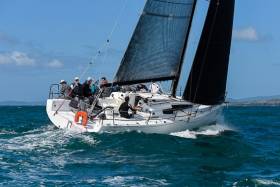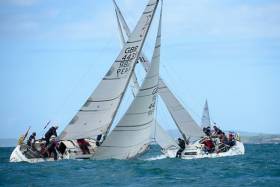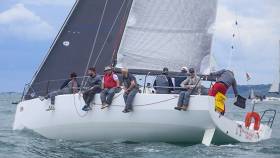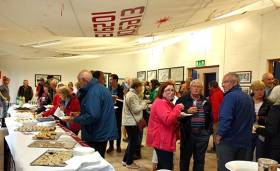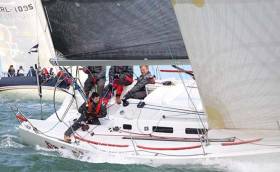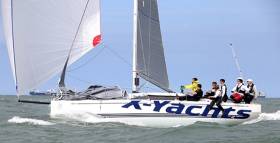Displaying items by tag: Calves Week
Calves Week 2016 Finishes in Sunshine & Light Winds
The final race of GAS Calves Week 2016, the Fastnet Race, took place on Friday 5th August in sunshine and light westerly winds of 9-13 knots. The Principal Race Officer, Neil Prendiville, moved the race around the Rock from its usual Thursday slot to avoid sending the 73 crews entered in the Regatta through a heavy Atlantic swell pushed up by the gale that passed through earlier in the week.
The mild conditions allowed Neil to send the Class 0/1 fleet on a 25 mile long route to a windward mark by Long Island, and then east through the Gascanane Sound around Clear Island and on a windward leg up to the Rock. The lead boats finished in just under 4 hours to round off a successful week of sailing. The other fleets were sent on a more direct route, to the windward mark and out to the Rock, with the Class 2 and 3, and larger Whitesail boats, set an extra challenge to round Goat Island to the north east before heading back to the harbour.
In class 1 Paul O Higgins’ new flying machine ,the JPK 10.80 with Mark Mansfield on the helm, had done enough in the Tuesday and Thursday racing to hold off all challengers to win both Class 1 IRC and Echo overall, ahead of Royal Cork’s True Penance (Darrer/Garvey) in IRC and Chris Moore’s J109 Powder Monkey from the National Yacht Club.
In class 2 the Desmond/Ivers /Deasey, Bad Company secured a first place in the Fastnet Race to hold off the challenge in IRC of Ernie Dillon’s Rioja while in Echo Andrew Algeo from the home sailing club had done enough to win the class overall despite Corby 25 Smile, Rob Allen from Galway Bay securing a first in the Fastnet Race.
In class 3 IRC the J 24 YaGottaWanna’s second in the Fastnet Race was enough to secure an overall win of the series to stay marginally ahead of David Buckley’s Boojum from Tralee Sailing Club. Boojum was also unlucky to miss out on the ECHO win to local boat Quinsea sailed by brothers Barry and Denis Quinlan whose first place in the Fastnet Race was enough to secure the series win and the coveted Best Local Boat award.
In Class 4 the Kirby/Norris crewed Raffles edged out Kinsale’s Saoirse, helmed by Richard Hanley for the series in both IRC and Echo despite Saoirse’s win of the Fastnet Race in both classes.
In the white sail 1 IRC class Brian Heffernan’s Aisling won the class ahead of Act Two from the Royal Irish, and ahead of his relation Aidan Heffernan’s Indulgence in Echo.
In class 2 WS KYC member John O Regan in Main 4 managed to hold off the challenge by fellow club member Stephen Lysaght on Reavra for the series win.
Rockabill Leads As Calves Week Concludes Today With Fastnet Race
Following Wednesday's Calves Week cancellation of racing due to severe weather, the five hundred plus crew members in the 73–boat fleet awoke yesterday to a blue sky and a fresh northwest breeze of 15 to 20 knots. Principle race officer Neil Prendeville set up his start line north of the Calve Islands, and succeeded in squeezing in two races for all six fleets using a windward mark off Long Island and then exploiting the scenic natural features of the western and middle Calves as marks on the course. See Bob Bateman's Calves Week Photo Gallery HERE.
In class 1, Paul O Higgins' new JPK 10.80 Rockabill with Mark Mansfield on the helm, continues to dominate the class with three wins in IRC after a tough battle with Connor Doyle's Freya, while holding off the new 36.7, Altair from Cove sailing club in echo.
In class 2, the Desmond/Ivers /Deasy, Bad Company still leads the class with a third and first in IRC ahead of Ernie Dillons Riojo, while in Echo Andrew Algeo from the home sailing club continues to lead overall ahead of Henry Hoggs Lisador from the Garrykennedy sailing club.
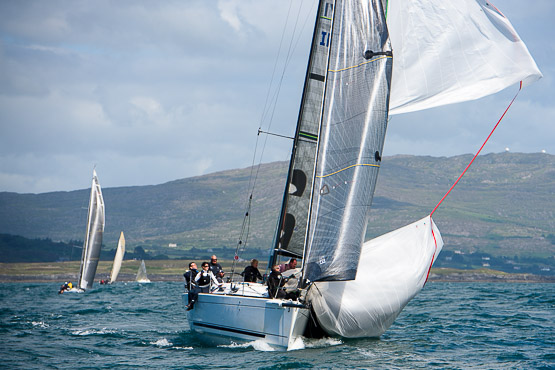 A spinnaker tears during racing at Calves Week. Photo: Bob Bateman
A spinnaker tears during racing at Calves Week. Photo: Bob Bateman
In class 3 IRC, the J 24 YaGottaWanna continues a very successful season with a first and second in IRC to stay marginally ahead of David Buckleys, Boojum from Tralee Sailing Club who continues to lead in Echo ahead of the Hunter 707 Hot Pants 3 from Howth.
Class 4 IRC continues to be an all Schull affair with the Kirby/Norris crewed Raffles swopping places with Michael Murphys Shelly D while in Echo a very popular local skipper Kevin Murray took one of the trophy’s in Echo.
In the white sail 1 IRC class Brian Heffernans Aisling with a first and second continues to lead the class ahead of Act Two from the Royal Irish, while also leading Echo ahead of his relation Aidan Heffernans Indulgence.
In class 2 WS Stephen Lysaght's decision to opt for white sail instead of class 2 appears to be paying off as he remains in close battle with fellow KYC member John O Regan in Main 4.
The final race of the series continues on Friday with the re scheduled Fastnet Race.
Calves Week 2016 Photo Gallery
This week's record breaking Calves Week fleet was photographed today by Bob Bateman. The fleet of 73 cruisers in six fleets has an increased UK presence this year.
The four–day regatta concludes tomorrow.
Royal Irish Yacht Rockabill VI Makes Great Start To Calves Week
GAS Calves Week 2016 started today with a final fleet of 73 cruisers in 6 fleets presenting for the racing arranged once again by Principal Race Officer Neil Prendiville and team. With an increased UK presence and new boats travelling from harbours around the Irish coast, the four–day Regatta, already an established event on many cruisers' annual calendar, has extended its reach.
After the heavy rain of the previous day, the conditions and visibility had improved considerably. Despite this, a number of the lead boats had to rely on GPS to locate the pre-positioned windward mark to the south of Long Island in the middle of Roaringwater Bay. The fleets started outside Copper Point and sent on a long windward beat and then around the Calf Islands once, twice or three times. Given the light wind conditions, varying between 6 and 14 knots, and between W and WNW as the race proceeded, a heavy swell and the flooding tide, tactical positioning counted heavily for those in a position to feature in the places. Honours were spread fairly evenly between clubs sending representatives.
Paul O'Higgins (RIYC) in his new JPK 10.80 Rockabill VI secured honours in both Class 0/1 IRC and ECHO in these difficult conditions, ahead of two Royal Cork boats, True Penance (Darrer/Garvey) in IRC and Altair (Dorgan/Losty) in ECHO. RCYC however swept honours in Class 2, with J80 Rioja (Baxter/Dillon) winning ECHO honours ahead of Galway Bay's Rob Allen on Smile, but losing out to fellow Crosshaven skipper Frank Desmond on his Sunfast 32, Bad Company.
RCYC also took IRC honours in Class 3 with the Lane/Enright partnership on J24 YouGottaWanna, edging out Tralee Bay's Boojum, the Sigma 33 of David Buckley. Local boats featured in the ECHO contest, with the Quinlan consortium on Quinsea (SHSC) winning the honours ahead of John Molloy's Holland 25, Manzanita. In Class 4 IRC, local boat, Sadler 32 Raffles (Tom Kirby/Sean Norris) was ahead of Kinsale Yacht Club Saoirse with Richard Hanley. In ECHO, however, Kirby and Norris had to settle for second place behind local rivals, O Buckley on Tete a Tete (SHSC).
In the hotly contested Whitesail categories, the conditions suited Bob Rendell's XC45 Samatom (HYC) ahead of Sean O'Riordan's YDream (KYC) in IRC. Brian Heffernan on Aisling (RCYC) took ECHO honours ahead of Dublin based Philip Smith on Just Jasmine (RIYC). In Whitesail 2, which is ECHO only, Kinsale Yacht Club shared the honours with Stephen Lysaght's Reavra ahead of John O'Regan on Main 4.
Calves Week Attracts Fleet of 74 for Roaringwater Bay Races
74 boats from around Ireland and the UK have arrived for this year's GAS Calves Week 2016 in Schull Harhbour, West Cork writes Oonagh Buckley. They were welcomed on a wet night by the organising committee to a reception provided by local producers such as West Cork Pies and Gubbeen Smokehouse, washed down with Cork Dry Gin.
The weather promises to improve for the opening day's sailing around the islands of Roaringwater Bay. Neil Prendiville has returned as Race Officer for the week which promises all types of conditions for the six competing fleets.
Next month's ICRA Nationals at Howth Yacht Club will feature what looks like the 'hottest cruiser fleet of the year' when class one boats resume battle after last year's epic clash at Kinsale.
Paul O'Higgins new JPK 10.80 will be up against some good J109's (including John Maybury's Joker which won ICRAs in 2015, Jelly Baby from Cork, Storm from Howth and J/109 newcomer Tim Goodbody). Also in the class one mix will be the A35 Fools Gold which was second to Joker at Kinsale and also won the Scottish series 2015 overall. Former champion, the XP33 Bon Exemple, skippered by Philip Byrne of the Royal Irish, is also a contender.
The cruiser racer body says its decision to apply 'equal status and trophies to IRC and Progressive Echo has attracted support' and overall entries for the championships is now in the sixties. The event is timed to lead into the Round Ireland, WIORA and Cork Week and Calves Week in a summer of racing highlights.
Although an early discount deadline has now passed, organisers have made the decision to extend it, presumably because they see there is still lots of potential entries to still emerge in each division.
Class two should be very competitive as well with four Half Tonners vying against the home club's X332 Equinox (Ross McDonald) plus a few others. Half tonners won't have their pro sailors however as ICRA rules only allow pros in classes 0 and 1.
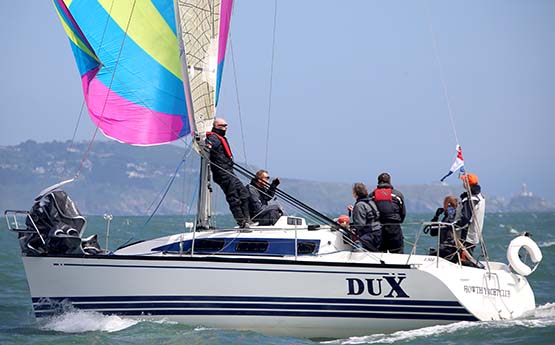
Dux from HYC will compete in class three
Class three will see Fusion the Corby 25 of Colwell, Cobbe and Ronan pushed by likes of Anthony Gore Grimes in Dux, the Sigma 33 s and the ICRA Commodore's family boat from Foynes Yacht Club, the McGibney's Dis a Ray.
The event is under the experienced Chairmanship of Chris Howard who has twice before run championships with ICRA at this County Dublin venue.
The programme will provide seven races over three day from Friday 10th to Sun 12th June with a mix of windward/leeward courses and interesting round the cans courses.
ICRA will be presenting overall matching perpetual trophies for IRC and ECHO in each Division in addition to ISA Gold, Silver and Bronze medals smartly mounted which are unique to the National championships.
ICRA's Corinthian Cups are also competed for in both Progressive Echo and IRC will provide equally interesting courses, specifically designed for the non spinnaker divisions with overall trophies and glass mountings as prizes.
Entries Heat Up for ICRA Nationals At Howth Yacht Club
The ICRA Nationals returns to Howth Yacht Club in early June, timed to lead into the Round Ireland, WIORA and Cork Week and Calves Week to round off a summer of racing.
The combination of IRC and Progressive Echo divisions in all Classes with equal Trophies and ISA National Championship Gold, Silver and Bronze medals ensures strong interest through the fleets. The event is under the experienced Chairmanship of Chris Howard who has twice before run championships with ICRA at this County Dublin venue.
An early entry list is admittedly still building but it already features top boats with the likes of Conor Phelan's Jump Juice returning from his success in March's RORC's Easter Challenge.
Early indications are that the hottest fleet could be in class one where, like ICRAs in 2015, some of the most competitive sailing took place. Paul O'Higgins new JPK 10.80 will be up against some good J109's (including John Maybury's Joker which won ICRAs in 2015, Jelly Baby from Cork, Storm from Howth and J/109 newcomer Tim Goodbody). Also in the class one mix will be the A35 Fools Gold which was second to Joker at Kinsale and also won the Scottish series 2015 overall. Former champion, the XP33 Bon Exemple, skippered by Philip Byrne, is also a contender.
Class two should be competitive as well with four Half Tonners vying against the home club's X332 Equinox (Ross McDonald) plus a few others. Half tonners won't have their pro sailors however as ICRA rules only allow pros in classes 0 and 1.
Class three will see Fusion the Corby 25 of Colwell, Cobbe and Ronan pushed by likes of Anthony Gore Grimes in Dux, the Sigma 33 s and of course, the ICRA Commodore's family boat from Foynes Yacht Club, the McGibney's Dis a Ray.
Class four will see current National Champions Kilcullen the local Howth Yacht Club youth J24 team take on the J24 fleet including the ICRA Commodore Simon MC Gibney the well sailed quarter Tonners and likes of Impalas who can all feature on their day
The Corinthian Cups are well established for the non spinnaker boats and are expected to attract a large fleet.
The early Discount deadline for the ICRA Nationals is 6 th May so get your entry in and enjoy great racing and a fun social scene ashore.
Calves Week Gets Change of Conditions on Day Three
#calvesweek – Very light wind conditions from the southwest, with a forecast for them to drop further over the afternoon, on day 3 of Cork Dry Gin Calves Week 2014 made a sharp contrast to the first few days' racing. The changeable conditions challenged helmsmen to keep spinnakers filled with many boats resorting to long reaches to attain the downward mark.
From the start outside Schull Harbour, all classes were sent on a 2 mile long windward leg to a laid mark south of Goat Island. Most classes then turned onto a broad reach southwest towards the Calf Islands with a gybe west of the Middle Calf to head north back to the Amelia Rock. A further windward/leeward loop proved unattainable for the majority of classes with the race ended at that point. Class 4 and Whitesail 2 were able to complete a windward/leeward loop in the time available.
The conditions ultimately forced Race Officer Neil Prendiville to curtail the race for all classes after over 3 hours of slow progress. Despite that, the warm, sunny weather that has been a feature of this year's Regatta meant few complaints among crews on a more restful day after the excitement of the Fastnet Race.
Paul O'Higgins made the most of the conditions in his Corby 33, Rockabill V to win IRC Class 0/1, ahead of Conor Doyle in Freya (Kinsale YC) and Rob McConnell in Fools Gold (Waterford Harbour SC). Freya was ahead in Echo however ahead of fellow Kinsaler Thomas Roche (KYC) on Meridian and Rockabill V. In Class 2 IRC, Dexterity from Foynes YC (McEneff/Madden/Hobbs) again had another win ahead of local rival Big Deal (Derek Dillon, Foynes YC) and the Cobh-based Corby 27, Kodachi (Denis Ellis, CSC) ORegan KYC). Dexterity and Kodachi swopped places in the Echo handicap placings.
Another Cobh boat, Muskateer (Billy Burke/Danny McCarthy) took Class 3 IRC honours and a second place in the Echo ratings, ahead of Jimmy Nyhan on Outrigger (RCYC) in both, with Gary Fort's J24, Jaguar from Tralee Bay third in IRC. Padraig O Donovan on Chameleon (KYC) continued his great run with first place in the Echo Class 3.
Local Boat, Shelly D, Mick McCarthy, again won Class 4 IRC. Visiting boat Andraxi (Chris North) was pipped for first place in Class 4 Echo by local man Simon Nelson on Witchcraft (SHSC), with Edmund Krugel (SHSC) on Barossa third.
In the fleet of larger whitesail boats, Kinsale-based Ger Hayes found the conditions suited him on his Beneteau First 36.7, Y-Dream and was ahead in both IRC and Echo of Aidan Heffernan (RCYC) on Indulgence. John Downing in Samba (RCYC) placed third in IRC and Samatom (Bob Rendell) in Echo. In Whitesail 2, Lady T (Michael Lynch, RCYC) took IRC honours, with local sailor James Crowley on La Perle Noire pipping him at the post for Echo honours.
Wise Decision to Hold Calves Week Fastnet Race A Day Early
#calvesweek – As indicated yesterday (Tues), the Cork Dry Gin Calves Week Organising Committee decided to run the showpiece race of the week a day earlier than had been planned, and yesterday the six racing fleets set sail out through Roaringwater Bay to the Fastnet Lighthouse writes Claire Bateman. After a slight delay to the start to ensure the full fleet had assembled.
With a fair forecast, and a steady 15 knot northwesterly, Race Officer Neil Prendiville ensured a full day's racing for all. He sent the smaller boats in Whitesail 2, who were started first, and Class 4 around the Amelia and on a fast close reach out directly to the Fastnet Rock and back. Whitesail 1, and Class 3 included a windward leg through the Calf Islands and around a laid mark south of Long Island, before the turn towards the Rock. Classes 0/1 and 2 had to complete a further downward/windward leg from the Fastnet Rock around Clear Island, and a blustery run north through the Gascanane Sound and northwest around West Calf Island for the Class 2 fleet and Goat Island for the largest Class 0/1 boats before a spinnaker run to the finish.
Royal Cork's Colman Garvey in True Penance won IRC Class 0/1 ahead of WHSC's Rob McConnell in Fools Gold and yesterday's winner, Kinsale's Conor Doyle, in Freya. In ECHO, three different boats took the spoils, with Peter Boylan's Sweden 45 , Annabella RIYC, ahead of Tom Roche's Meridian from Kinsale and local sailor Gabby Hogan's Grand Soleil 43, Growler. In Class 2 IRC, The McEneff/Madden/Hobbs Dexterity from Foynes YC won the day ahead of local rival Big Deal Derek Dillon, also fromFoynes YC and John O'Regan's The Main 4 from Kinsale. In ECHO Royal Cork's Ernie Dillon on Silke Breeze scored one up on his brother's result in IRC, ahead of The Main 4 and Raphael Crowley's Huntress from Tralee Bay.
The different racing conditions suited different boats in both Class 3 and 4. Dungarvan's Dan O'Donovan on Seconds Count was ahead on corrected time of both Gary Fort's J24, Jaguar from Tralee Bay and Jimmy Nyhan of Royal Cork on Outrigger. Bombora had a great win in ECHO Class 3 with Kinsale's Padraig O Donovan on Chameleon having a great regatta to date with a second placing in ECHO ahead of Frank O'Hara's, SHSC First 300, Chinook.
Michael Murphy's Shelly D won Class 4 IRC and was placed third in ECHO behind two local rivals, Schull's Kevin Murray on Dovita of Colla and Oonagh Buckley on Tete a Tete (SHSC).
In the fleet of larger whitesail boats, John Downing in Samba (RCYC) received his second first place in IRC ahead of the Roche/O'Leary/Andrews Act 2 and Bob Rendell's Samaton. ECHO honours went to Royal Cork's Conor Phelan in Endeavour ahead of Ken Burke from Howth Yacht Club on Savarna and Don McCarthy on VSOP (SHSC). In Whitesail 2, Tom McCarthy on Ashanta again took IRC honours, with local boat Dreamcatcher Frank Murphy, SHSC ahead of Michael Hearn on Summerfly and Cork boat, Tuna Brendan Buckley, RCYC.
Light winds are forecast for the remainder of the regatta, but as ever who can really tell and West Cork can be full of surprises.
Entry Boost Gets Calves Week Off to a Flying Start
#calvesweek – There has been a marked increase in entries to Calves Week this year writes Claire Bateman. Entries are up 25% with boats coming to Schull from clubs around the coast for the 4 day regatta. Boats from Waterford and Kerry Sailing Clubs are joining the usual strong contingents from Kinsale, Crosshaven and Dublin, and a few new visitors from the UK completed the strong racing line up. With 15 boats competing in some classes, some great days' racing is promised in the Cork Dry Gin sponsored event.
With light winds from the south east backing south forecast for the starting day's racing, Race Officer Neil Prendeville kept the starts clean with separate guns for the four cruiser classes as well as the two Whitesail classes outside Copper Point. He chose a windward course for the fleets out around the Calf Islands. The cruisers were able to hoist their spinnakers from a laid mark south of West Calf Island with a leeward run back to the Amelia Buoy. Class 0/1 completed 3 rounds with the other classes completing fewer laps. A sailing breeze picked up, allowing the various fleets the opportunity to complete before the weather unexpectedly closed in.
With a spread of entrants from sailing clubs around the country, racing competitively against each other, winners were produced from around the country. Conor Doyle in Freya from Kinsale YC) took line honours and won Class 0/1, IRC ahead of Colman Garvey in True Penance (RCYC) and Rob McConnell in Fools Gold (Waterford Harbour SC). In Echo, Freya again took the honours, ahead of local boat Infinity with Dave Harte and Des Cummins in Dear Prudence (RStGYC). In Class 2 IRC while Dexterity from Foynes YC (McEneff/Madden/Hobbs) took line honours, on corrected time the day went to Frank Desmond, RCYC, on Bad Company ahead of Derek Dillon, Foynes YC, in Big Deal and Viking with Robert Dix/Brian McKernon (Howth YC). Big Deal took Echo honours, ahead of Val Kriss (Nigel Dann, KYC) and Bad Company.
Class 3 saw a 1:2 punch for Cobh SC, with Billy Burke and Danny McCarthy's Sigma 33, Muskateer, first over the line in Class 3 and rewarded with first in both IRC and Echo, ahead of Adrian Tyler on a Hunter Impala, Whyte Knight. Jimmy Nyhan on Outrigger (RCYC) and Padraig O Donovan on Chameleon (KYC) took third in IRC and Echo respectively.
Saoirse, under Richard Hanley from Kinsale YC won Class 4 IRC and Echo respectively, ahead of local boats Witchcraft (Simon Nelson) and Barossa (Edmund Krugel) in Echo.
In the fleet of larger whitesail boats, John Dowling in Samba (RCYC) crossing the line first and getting both IRC and Echo honours. Ger Hayes' First 36.7, Y-Dream took second in both handicaps. Dufour 425 Act 2 (Roche, O'Leary, Andrews) took third place in IRC, and new entrant Samatom, a UK based
XC45 sailed by Bob Rendell, was third in Echo. In Whitesail 2, Ashanta took IRC honours, with local boats Aoife under Hugh O'Donnell, and Giggles under Peter Morehead, first and second in Echo, ahead of Calypso, another UK based boat under John McCarthy (MBSC).
In keeping with friendly nature of the club, any newcomer to Schull has been offered a "buddy boat" – a local captain to share important details like the need for attention to the local sailing hazards and where to get a good meal after an






























